Earliest days
With new trains on order and a widespread re-allocation of rolling stock, it is an opportune time to ponder rolling stock design.

From the earliest days of railways, British trains were based on the design of the stage coach. From this was evolved the Victorian compartment coach, with bench seats running across the width of the vehicle and a hinged door to each compartment on each side. First came four-wheelers, with a wheelbase of 15 feet and a length of not more than 27 feet, having up to five third-class compartments; these were the characteristic vehicle on, for instance, on London suburban railways such as the Metropolitan District Railway (above) and the North London Railway. They were also the standard for long distance trains until well into the 1890s.
In the later nineteenth century the standard length of British passenger coaches was progressively increased. First, came six-wheelers about 30 feet long, and then, from the 1870s, came bogie vehicles , initially 45 feet long, then 48 feet and 54 feet long. In the twentieth century the trend to longer vehicles continued. During the time of the Big Four private companies, the favoured length was about 60 feet, whilst the British Railways mark 1 stock was built to 57 and 64 foot 6 inch lengths, the former for sharply curved routes. Until recently the latter dimension remained an important standard as it formed the basis for the C1 loading gauge, with a vehicle length of 19.330 metres and bogies at14.174 centres; the same dimensions, rounded, were adopted for recent 20 metres (nominal) stock such as Electostars and the Siemens class 450 Desiro.
After 1970 it was realised that 23 metre vehicles, with bogies at 16 metre centres, could run over much of the system, and this dimension was adopted for such stock as mark 3, and later, DMU classes 155, 156, 159 and Turbostars. Longer vehicles were also introduced with successive builds on London Underground. But the added width was obtained at the cost of width. Whereas the C1 loading gauge for 20 metre vehicles permits a overall external width of 2.82 metres, mark 3 stock is only 2.74 metres wide, class 158/159 stock is 2.7 metres wide and the Siemens class 444 Desiros are 2.6 metreswide. These longer vehicles are also problematic on some routes, as they are running on infrastructure designed for the short Victorian four-wheelers; some station platforms are built on curves which are too sharp for the longer modern vehicles and the difficulties this causes will be discussed below.
In the later days of slam door stock, the practice was to have one door each side per compartment or seating bay on suburban stock and three doors per side on long distance stock.

Above is a suburban train of this type, dating from the 1930s. This style of coach, with 108 seats in nine compartments within a vehicle 57 feet long, optimised the seating capacity and minimised station dwell time. They remained popular with operators and passengers and the design was perpetuated when new electric multiple unit trains were procured in large numbers in the 1950s and 1960s. But they were the last of their kind. Accidents with the outward-opening doors were quite common and the separate compartments came to be perceived as unsafe. The compartment problem was solved by creating a gangway down the length of the vehicles, slightly reducing the seating capacity, but the danger of hinged doors not under the control of railway staff was never solved.
Parallel to this tradition originating in the stage coach was another, derived from the wagon, with a long saloon and doors at each end, reached, in the earliest examples, from an open balcony, which later evolved into the enclosed end-vestibule. This came from North America and was brought to Europe in the shape of the Pullman car. From a structural point of view this was a superior design as the passenger saloon could be built as a strong square-section tubular enclosure.

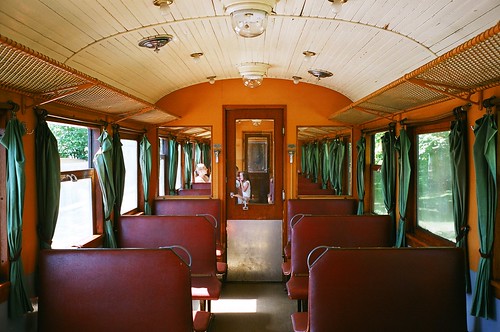
This style of vehicle was the prototype for new trains built for the London Underground when it was electrified in the early 1900s, as well as for the tube which started to be built around the same time. But soon it was discovered that the end doors were insufficient, and intermediate doors were provided so as to speed up loading and unloading at busy stations. Over the years, this evolved into the modern type of London Underground train with two pairs of wide double doors and single doors at each end of the vehicle.
British long distance stock eventually came to be built to the end-door design as it lent itself perfectly to monocoque construction, with, depending on the design philosophy, a protective or sacrificial end-zone for crash protection. A good example of this practice is the mark 3, seen below, in the electric multiple unit version, the class 442 built for the Bournemouth line, with power-operated doors at the extreme outer ends.
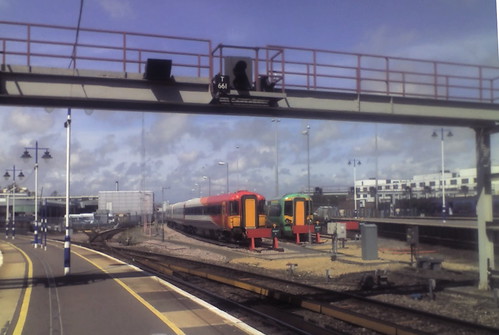
But now, the limitations of the Victorian infrastructure become apparent. The trains have been transferred to the Brighton line and are running on Brighton and Gatwick Express services. It turns out that they are awkward to get on at convex curved platforms, owing to the large gap. Southern was not keen on taking these trains into its fleet because of amongst other reasons, the station dwell time for this type of stock is reputed to be excessive, but was apparently unaware of the problem of the gap at convex platforms.
A similar problem occurs with the 23 metre long Turbostar trains (below), with doors about four metres from each end, the so-called 1/3:2/3 layout, but in this case, the gap occurs on concave platforms as the vehicles cut off a chord.

But not all 23 metre vehicles are troublesome in this way. The class 158 stock (below) has doorways over the bogie centres, which minimises the gap between platform and train in all circumstances. But these trains are notorious for their station dwell times and this is why the design of the later Turbostar, and most electric multiple units has been based on the Networker suburban configuration with 1/3:2/3 door configuration.
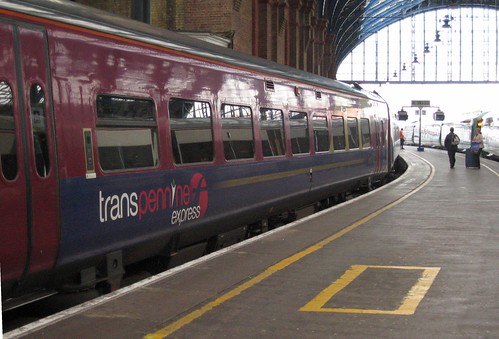
The demise of the compartment coach

The final examples of the traditional compartment coach were like these above, built in very large numbers by British Railways from the mid-1950s. These were formed into electric multiple unit trains and used on suburban services. They would remain in service until the end of the twentieth century. In the late 1960s it was decided to adopt trains with power-operated sliding doors similar to those used on London Underground. Prototypes were built, with three pairs of sliding doors per side trains, but the production series had only two pairs of doors per side, and from then on the now familiar 1:3/2:3 door configuration became standard on the national railway system - although the LMS company had built a fleet to this layout for Liverpool suburban routes in 1939 and the LNER for London and Manchester suburban routes in 1946.
An example of the first of these, class 313, with aluminium panelling, built in 1975 for the electrification of the Great Northern routes out of London, is shown below.
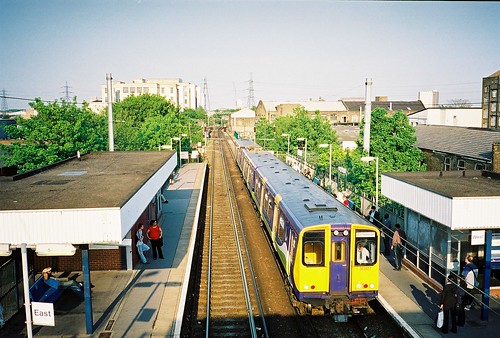
As soon as they entered service, it was apparent that they were not ideal for congested inner suburban routes. The doors were only 1.2 metres wide, and, ignoring London Underground's experience, there was no standback space to either side of the draught screens. At busy periods, therefore, passengers alighted and boarded in single file, with the result that station dwell times were extended in comparison to the slam door trains they replaced. However, the configuration was perpetuated in huge numbers. Fleets were procured for the Great Eastern, Glasgow and Liverpool suburban routes (classes 313, 314, 315), and the same basic design was adapted for mark 3 steel construction and put into service in South West London, the Cambridge route, the Glasgow suburbs, and London Midland outer suburban lines (classes 317, 319, 319, 320, 321, 322) .
By 1986, British Rail had been divided into Sectors, and one of these, London and South East, was rebranded Network South East and designs for a new fleet of trains put in hand to replace the remaining slam door stock. This eventually appeared as the Networker, in 20 metre electric multiple unit versions mostly for South-East London suburban routes and as a 23 metre diesel multiple unit for Great Western routes; the latter was constructed to the full 2.82 width, which the larger Great Western clearances made possible.
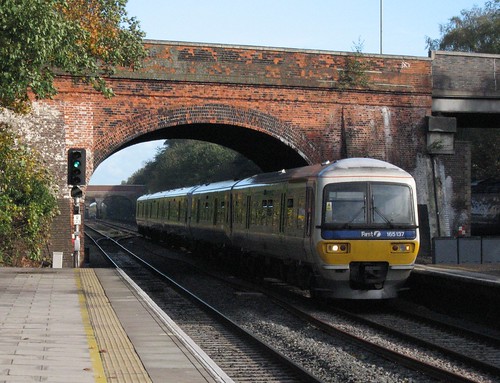
These continue the 1:3/2:3 door layout but the doors were of the plug type, sliding outside the vehicles and eliminating the need for space-consuming sliding door pockets. But design of the plug doors required a closing lip on the floor, creating a shallow step and reintroducing the narrow step-board - less than 150 mm from nose to riser - which was one of the less satisfactory features of slam door stock.
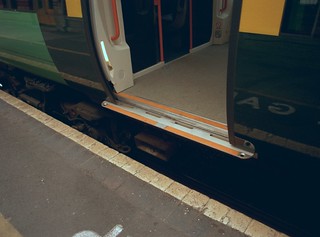
This has become a feature of all suburban stock with plug doors - including the Bombardier Electrostars, and Turbostars, and the Siemens Desiros. In some circumstances, it can present a hazard, especially at low concave platforms such as this one at Lewes. The difficulty of boarding and alighting is compounded by the position of the door handles, which is a bit too far inside the train to reach comfortably. The plug doors proved troublesome initially, due to their complexity, and the safety devices caused delays as it they could not be opened until 15 seconds after the train had stopped, with further delays before the train could start again after they were closed. This led to the abandonment of the plug door in favour of the older type of pocketed sliding door. These are a feature of later Electrostars of class 376, as used in South-East London services where they replaced Networkers after less than 15 years in service.

But one of the desirable features of slam door stock has never been replaced at least not in the UK - the door provided support over the gap between the platform and the train, and nearly all passengers held on to it when getting on and off.
Length and width
There is a relation between the length and width of a railway vehicle. In the earliest part of the twentieth century a maximum external width of 2.82 metres became standard. This was incorporated into the C1 loading gauge, and applied to vehicles of a nominal 20 metres length (63 feet 6 inches) and having bogies at 14.174 metre centres. In the late 1960s it was realised that a 23 metre long vehicle, with bogies at 16 metre centres, was possible. These emerged as mark 3 stock, having a width of 2.74 metres, and limited to routes cleared for a new C3 restriction. Mark 3 stock has the same internal width as mark 1 stock due to the use of recessed door handles, and ends are slightly tapered. Bogies are 3.5 metres from the ends of the vehicles, giving rise to considerable relative movement between vehicles on curves, and consequent wear and tear on gangway connection.
The maximum width of vehicles is determined by a formula which can be used to determine the extent of overthrow and kick-out on curved track. The most important term in the equation is that relating to the distance between the bogies. The width must be reduced from the maximum permitted by an amount proportional to the square of the distance between the bogies. Calculations based on 160 metre radius curvature show that a vehicle about 21.2 metres long with bogies about 15.2 metres apart need be little narrower (2 cm) than the maximum permitted, still currently 2.82 metres. This will provide nine bays of 1.90 metres, plus space for vestibules and standard toilets.
Conclusion
The situation remains unsatisfactory. A 23 metre vehicle is sub-optimal from the point of view of width and consequent comfort, whilst none of the stock from the class 313 of 1975 until the later class 376 Electrostars has performed as intended. There is a shortage of seating capacity and station dwell times are excessive, due to the lack of circulation space inside the doorways. It is likely that the awkward step associated with the use of plug doors also prolongs station dwell times as people have to tread carefully.
In an attempt to deal with the problem of station dwell times, most of the suburban sliding-door stock from this period has been rebuilt to give additional circulation space, or redeployed to longer distance routes. Of course, circulation space can only be provided at the expense of seats.
The latest Electrostars for London Overground take this principle to an extreme, being fitted with sliding doors and longitudinal seats only. So long as they are used only for short trips, this is probably an acceptable solution, and apart from their weight, is the most appropriate use and configuration of this type of stock.
With new trains on order and a widespread re-allocation of rolling stock, it is an opportune time to ponder rolling stock design.

From the earliest days of railways, British trains were based on the design of the stage coach. From this was evolved the Victorian compartment coach, with bench seats running across the width of the vehicle and a hinged door to each compartment on each side. First came four-wheelers, with a wheelbase of 15 feet and a length of not more than 27 feet, having up to five third-class compartments; these were the characteristic vehicle on, for instance, on London suburban railways such as the Metropolitan District Railway (above) and the North London Railway. They were also the standard for long distance trains until well into the 1890s.
In the later nineteenth century the standard length of British passenger coaches was progressively increased. First, came six-wheelers about 30 feet long, and then, from the 1870s, came bogie vehicles , initially 45 feet long, then 48 feet and 54 feet long. In the twentieth century the trend to longer vehicles continued. During the time of the Big Four private companies, the favoured length was about 60 feet, whilst the British Railways mark 1 stock was built to 57 and 64 foot 6 inch lengths, the former for sharply curved routes. Until recently the latter dimension remained an important standard as it formed the basis for the C1 loading gauge, with a vehicle length of 19.330 metres and bogies at14.174 centres; the same dimensions, rounded, were adopted for recent 20 metres (nominal) stock such as Electostars and the Siemens class 450 Desiro.
After 1970 it was realised that 23 metre vehicles, with bogies at 16 metre centres, could run over much of the system, and this dimension was adopted for such stock as mark 3, and later, DMU classes 155, 156, 159 and Turbostars. Longer vehicles were also introduced with successive builds on London Underground. But the added width was obtained at the cost of width. Whereas the C1 loading gauge for 20 metre vehicles permits a overall external width of 2.82 metres, mark 3 stock is only 2.74 metres wide, class 158/159 stock is 2.7 metres wide and the Siemens class 444 Desiros are 2.6 metreswide. These longer vehicles are also problematic on some routes, as they are running on infrastructure designed for the short Victorian four-wheelers; some station platforms are built on curves which are too sharp for the longer modern vehicles and the difficulties this causes will be discussed below.
In the later days of slam door stock, the practice was to have one door each side per compartment or seating bay on suburban stock and three doors per side on long distance stock.

Above is a suburban train of this type, dating from the 1930s. This style of coach, with 108 seats in nine compartments within a vehicle 57 feet long, optimised the seating capacity and minimised station dwell time. They remained popular with operators and passengers and the design was perpetuated when new electric multiple unit trains were procured in large numbers in the 1950s and 1960s. But they were the last of their kind. Accidents with the outward-opening doors were quite common and the separate compartments came to be perceived as unsafe. The compartment problem was solved by creating a gangway down the length of the vehicles, slightly reducing the seating capacity, but the danger of hinged doors not under the control of railway staff was never solved.
Parallel to this tradition originating in the stage coach was another, derived from the wagon, with a long saloon and doors at each end, reached, in the earliest examples, from an open balcony, which later evolved into the enclosed end-vestibule. This came from North America and was brought to Europe in the shape of the Pullman car. From a structural point of view this was a superior design as the passenger saloon could be built as a strong square-section tubular enclosure.


This style of vehicle was the prototype for new trains built for the London Underground when it was electrified in the early 1900s, as well as for the tube which started to be built around the same time. But soon it was discovered that the end doors were insufficient, and intermediate doors were provided so as to speed up loading and unloading at busy stations. Over the years, this evolved into the modern type of London Underground train with two pairs of wide double doors and single doors at each end of the vehicle.
British long distance stock eventually came to be built to the end-door design as it lent itself perfectly to monocoque construction, with, depending on the design philosophy, a protective or sacrificial end-zone for crash protection. A good example of this practice is the mark 3, seen below, in the electric multiple unit version, the class 442 built for the Bournemouth line, with power-operated doors at the extreme outer ends.

But now, the limitations of the Victorian infrastructure become apparent. The trains have been transferred to the Brighton line and are running on Brighton and Gatwick Express services. It turns out that they are awkward to get on at convex curved platforms, owing to the large gap. Southern was not keen on taking these trains into its fleet because of amongst other reasons, the station dwell time for this type of stock is reputed to be excessive, but was apparently unaware of the problem of the gap at convex platforms.
A similar problem occurs with the 23 metre long Turbostar trains (below), with doors about four metres from each end, the so-called 1/3:2/3 layout, but in this case, the gap occurs on concave platforms as the vehicles cut off a chord.

But not all 23 metre vehicles are troublesome in this way. The class 158 stock (below) has doorways over the bogie centres, which minimises the gap between platform and train in all circumstances. But these trains are notorious for their station dwell times and this is why the design of the later Turbostar, and most electric multiple units has been based on the Networker suburban configuration with 1/3:2/3 door configuration.

The demise of the compartment coach

The final examples of the traditional compartment coach were like these above, built in very large numbers by British Railways from the mid-1950s. These were formed into electric multiple unit trains and used on suburban services. They would remain in service until the end of the twentieth century. In the late 1960s it was decided to adopt trains with power-operated sliding doors similar to those used on London Underground. Prototypes were built, with three pairs of sliding doors per side trains, but the production series had only two pairs of doors per side, and from then on the now familiar 1:3/2:3 door configuration became standard on the national railway system - although the LMS company had built a fleet to this layout for Liverpool suburban routes in 1939 and the LNER for London and Manchester suburban routes in 1946.
An example of the first of these, class 313, with aluminium panelling, built in 1975 for the electrification of the Great Northern routes out of London, is shown below.

As soon as they entered service, it was apparent that they were not ideal for congested inner suburban routes. The doors were only 1.2 metres wide, and, ignoring London Underground's experience, there was no standback space to either side of the draught screens. At busy periods, therefore, passengers alighted and boarded in single file, with the result that station dwell times were extended in comparison to the slam door trains they replaced. However, the configuration was perpetuated in huge numbers. Fleets were procured for the Great Eastern, Glasgow and Liverpool suburban routes (classes 313, 314, 315), and the same basic design was adapted for mark 3 steel construction and put into service in South West London, the Cambridge route, the Glasgow suburbs, and London Midland outer suburban lines (classes 317, 319, 319, 320, 321, 322) .
By 1986, British Rail had been divided into Sectors, and one of these, London and South East, was rebranded Network South East and designs for a new fleet of trains put in hand to replace the remaining slam door stock. This eventually appeared as the Networker, in 20 metre electric multiple unit versions mostly for South-East London suburban routes and as a 23 metre diesel multiple unit for Great Western routes; the latter was constructed to the full 2.82 width, which the larger Great Western clearances made possible.

These continue the 1:3/2:3 door layout but the doors were of the plug type, sliding outside the vehicles and eliminating the need for space-consuming sliding door pockets. But design of the plug doors required a closing lip on the floor, creating a shallow step and reintroducing the narrow step-board - less than 150 mm from nose to riser - which was one of the less satisfactory features of slam door stock.

This has become a feature of all suburban stock with plug doors - including the Bombardier Electrostars, and Turbostars, and the Siemens Desiros. In some circumstances, it can present a hazard, especially at low concave platforms such as this one at Lewes. The difficulty of boarding and alighting is compounded by the position of the door handles, which is a bit too far inside the train to reach comfortably. The plug doors proved troublesome initially, due to their complexity, and the safety devices caused delays as it they could not be opened until 15 seconds after the train had stopped, with further delays before the train could start again after they were closed. This led to the abandonment of the plug door in favour of the older type of pocketed sliding door. These are a feature of later Electrostars of class 376, as used in South-East London services where they replaced Networkers after less than 15 years in service.

But one of the desirable features of slam door stock has never been replaced at least not in the UK - the door provided support over the gap between the platform and the train, and nearly all passengers held on to it when getting on and off.
Length and width
There is a relation between the length and width of a railway vehicle. In the earliest part of the twentieth century a maximum external width of 2.82 metres became standard. This was incorporated into the C1 loading gauge, and applied to vehicles of a nominal 20 metres length (63 feet 6 inches) and having bogies at 14.174 metre centres. In the late 1960s it was realised that a 23 metre long vehicle, with bogies at 16 metre centres, was possible. These emerged as mark 3 stock, having a width of 2.74 metres, and limited to routes cleared for a new C3 restriction. Mark 3 stock has the same internal width as mark 1 stock due to the use of recessed door handles, and ends are slightly tapered. Bogies are 3.5 metres from the ends of the vehicles, giving rise to considerable relative movement between vehicles on curves, and consequent wear and tear on gangway connection.
The maximum width of vehicles is determined by a formula which can be used to determine the extent of overthrow and kick-out on curved track. The most important term in the equation is that relating to the distance between the bogies. The width must be reduced from the maximum permitted by an amount proportional to the square of the distance between the bogies. Calculations based on 160 metre radius curvature show that a vehicle about 21.2 metres long with bogies about 15.2 metres apart need be little narrower (2 cm) than the maximum permitted, still currently 2.82 metres. This will provide nine bays of 1.90 metres, plus space for vestibules and standard toilets.
Conclusion
The situation remains unsatisfactory. A 23 metre vehicle is sub-optimal from the point of view of width and consequent comfort, whilst none of the stock from the class 313 of 1975 until the later class 376 Electrostars has performed as intended. There is a shortage of seating capacity and station dwell times are excessive, due to the lack of circulation space inside the doorways. It is likely that the awkward step associated with the use of plug doors also prolongs station dwell times as people have to tread carefully.
In an attempt to deal with the problem of station dwell times, most of the suburban sliding-door stock from this period has been rebuilt to give additional circulation space, or redeployed to longer distance routes. Of course, circulation space can only be provided at the expense of seats.
The latest Electrostars for London Overground take this principle to an extreme, being fitted with sliding doors and longitudinal seats only. So long as they are used only for short trips, this is probably an acceptable solution, and apart from their weight, is the most appropriate use and configuration of this type of stock.
Kommentarer